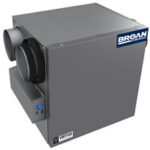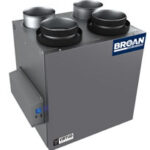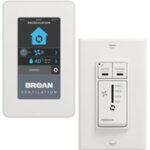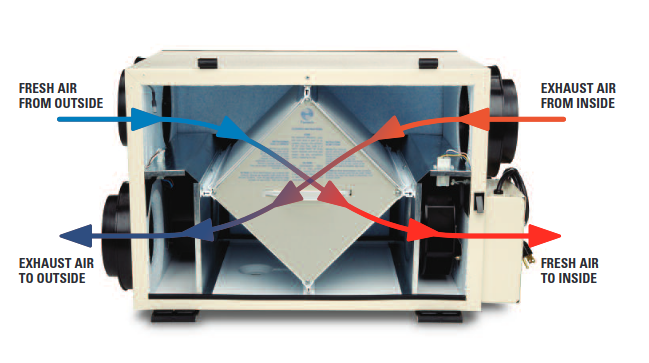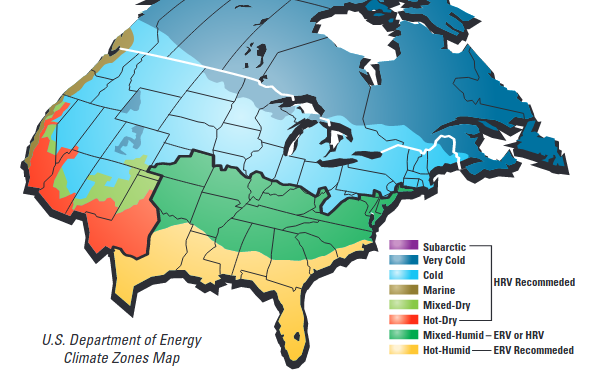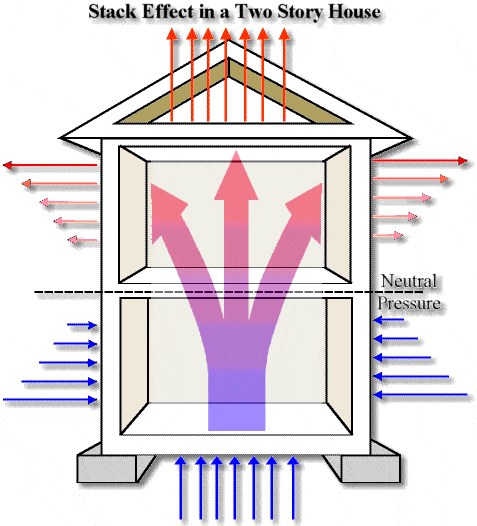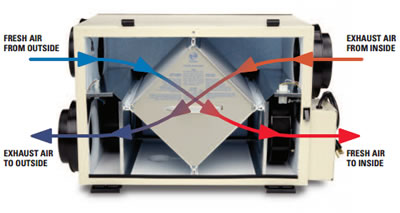It is now time to discuss the elephant in the room when it comes to kitchen ventilation…make up air. In elementary terms, it is as simple as “what goes out, must come in”.
With the trend of Commercial style ranges and other high output cooking devices, folks are having very large ventilation systems installed to evacuate the grease laden steam particles given off during cooking. While 1200 CFM for a kitchen fan sure sounds awe inspiring, and some ranges actually need this amount of flow…the reality is that as homes get tighter and more insulated, we are having a harder time getting air to feed this voracious fan. Years back, engineers could count on a fair bit of in-flow through gaps and other openings provided by lesser building standards that allowed make up air for not only the kitchen, but bath fans and clothes dryer as well. While this works, it is not ideal as during the winter you may be pulling in very cold air that begins to condensate in the wall and brings the possibility of mold growth. Therefore, if it can’t come in cleanly from outside, it will come down the chimney or worse, through the exhaust vents of gas fired appliances (water heater and the like). This situation is called Backdrafting and is quite dangerous as it can bring noxious combustion exhaust back into the house. We want to avoid this at all costs!
Recent code changes to certain areas (and with more to come) are calling for Make Up Air when the kitchen range fan exceeds 300-400 cfm. For most residential uses, this is fine. However, when we start getting up to the higher end of Exhaust Fans, Make Up Air should be in your Mechanical Ventilation Plans. There are several ways to accomplish this, and as many options depending on where you live and your expected comfort level…
LEED is of the idea that air should not be evacuated to the outside, thereby keeping the envelope in tact. They assert that a recirculating type system should be utilized that filters the air with the use of activated carbon. The reality here is that these fans are typically noisy and ineffective so they are unused and the grease ends up on cabinets and other surfaces. It is our belief that the air should be evacuated fully out of the structure to maintain good indoor air quality. In reality, the kitchen fan is used for short periods of time only once or twice a day, so the overall loss of conditioned air is quite small. LEED also prefers to see a fan with a maximum of 200-250 cfm (which is nice as it eliminates any need for make up air, and for a well built home in the passivhaus style is probably sufficient).
Now then, what can we do about all this to get air to the kitchen hood? Restaurants actually provide filtered make up air at the hood and range location to allow for massive amounts to be cycled as they have quite a heat and steam/grease load to contend with. It is a great way to go, but the hoods are quite bulky and are not especially pleasing to the eye, unless gleaming monoliths of stainless steel float your boat. Some folks hope their HRV can provide the difference…sadly, no it can’t. HRVs are made for balanced load conditions where they take and replace the same amount of air. We do have one unit that can over-pressurize if necessary, but it cannot come close to supplying what a large kitchen fan will require. Of course, if you live in California or other temperate zone, an open window can provide all the air you need at a minimum of cost.
For the rest of us…mechanical make up air must be provided, and here are some ideas:
Adequate – You can have an opening to the outside that is operated manually or via motor, and preheated if you live in colder climes. Whilst it would be desirable to filter this incoming air, the static losses across the filter may make it operate at a lesser level than anticipated.
Better – Having a powered opening to the outside, with booster fan of equal power to the range fan, and a heater for the incoming air (if necessary), and a filter box to clean the air. This would provide the air the fan needed, tempered with warm air to lessen the shock of cold incoming air.
Best – A self contained filtered, heated make up air fan similar (but smaller) that a restaurant uses. Ones such as supplied by Shelter Supply, and even Soler Palau would be ideal. These can be costly and large, but are definitely a hassle free way to go.
So now we have discussed the hidden parts, let’s get to the real hard part…”Exactly what is this going to look like in my dream kitchen?”
There are many ways to accomplish bringing air into the kitchen. Ideally, a grille in the wall behind the range would allow for proper mixing of contaminants with the fresh air before the ascent up the vent pipe. This would work best with filtered and heated air so as not to make the chef uncomfortable, but it could be any of the methods discussed earlier.
Something that is becoming increasingly popular is to put rectilinear grilles in the toekick of the cabinet to keep them out of sight as well as promote an up-welling flow of the air to ensure even airflow. This would likely be the easiest to accomplish if one were remodelling the kitchen versus new home construction.
An interesting option I discovered on the internet is to have the grille feeding air from a powered fan or passively to the kitchen hidden behind the refrigerator. This hides the grille nicely, and the coils of the refrigerator act as a small pre-heater to take the edge of the temperature. Quite ingenious I thought.
The last way would involve diffusers in the ceiling, fed by a fan or short length of duct work in the attic to provide for air when necessary. This is less than ideal in terms of where the air is entering, but will provide us with the air the kitchen fan will need.
In an ideal world, the Make Up Fan and kitchen fan would be of similar performance as we like to maintain a balanced situation. I have seen some standards which call for 2/3 or 3/4 of the airflow of the kitchen fan to be supplied as make up air. This of course relies upon the cracks of the house to make up the rest. Under most circumstances, this may be correct, but as homes get tighter and tighter I can’t see this ratio working for long. Even older homes are being retrofitted to be sealed more extensively for energy savings, so we can no longer assume the house will give up the air we need. A good plan would call for balanced airflow coming and going.
Lastly, you will want to have the Make Up Fan on a speed control as well, so you can adjust the amount of air coming in. No sense in bringing in 1000CFM if you are boiling water for tea with your range hood on low power. You could get a large capacity speed controller that will handle both fans at once, or have them on separate controls so you could choose when the Make Up Fan runs. There would be no need to run the Make Up Fan on a nice summer evening when you likely have doors and windows open.
